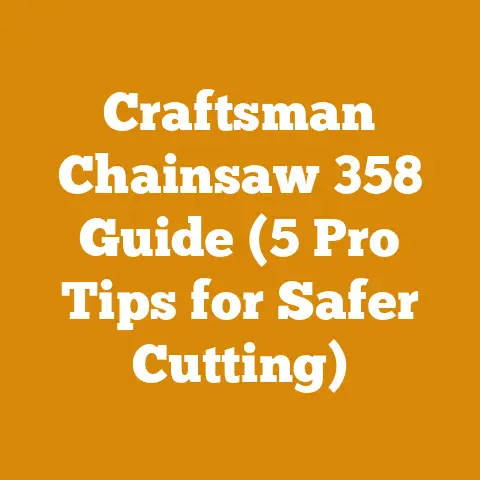Batten Shelving Guide (5 Pro Tips for Ideal Board Thickness)
Imagine this: You’re standing in your workshop, the scent of freshly cut pine filling the air. Sunlight streams through the window, illuminating dust motes dancing above your workbench. You’ve got a vision – a beautiful, functional batten shelving system to organize your tools, books, or maybe even your collection of vintage chainsaws. But something nags at you. What’s the ideal board thickness? Too thin, and your shelves sag under the weight of your prized possessions. Too thick, and you’re wasting precious lumber and creating an unnecessarily bulky structure. I’ve been there. I’ve built shelves that looked great for a week and then bowed like a tired old horse. That’s why I’m sharing these 5 pro tips for nailing batten shelving, focusing specifically on board thickness. It’s about finding that sweet spot between strength, aesthetics, and cost-effectiveness. Let’s dive in and build shelves that will last a lifetime.
Batten Shelving Guide: 5 Pro Tips for Ideal Board Thickness
Batten shelving, at its core, is a simple yet elegant solution for storage. It’s a system where shelves are supported by vertical battens attached to the wall. The beauty lies in its adaptability – you can customize shelf spacing, width, and depth to perfectly suit your needs. But the backbone of any good batten shelving system is the shelf itself, and its thickness is paramount. Get it wrong, and you’re looking at potential disaster.
1. Understanding Load and Span: The Foundation of Shelf Thickness
Before even thinking about grabbing a piece of wood, you need to understand two critical factors: load and span. Load refers to the weight your shelves will bear. Are you storing lightweight books, heavy power tools, or a mix of both? Span is the distance between your supporting battens. The longer the span, the thicker your shelves need to be.
-
Load Calculation: This is where a little planning goes a long way. Estimate the maximum weight you expect to place on each shelf. Be realistic! It’s better to overestimate than underestimate. Remember, weight is evenly distributed if you place items uniformly across the shelf. However, concentrated loads (like a single heavy object in the middle) will exert significantly more stress.
-
Span Considerations: The distance between battens directly impacts the shelf’s tendency to sag. Think of it like a bridge; the longer the bridge, the stronger it needs to be. A shorter span allows you to use thinner shelves, while a longer span demands thicker, more robust lumber.
My Experience: I once built a batten shelving unit for my workshop using what I thought was sufficiently thick pine. The span between battens was about 36 inches. I loaded it up with my collection of antique axes and splitting mauls. Within a few months, the shelves had developed a noticeable sag. I had to reinforce them with additional battens, a lesson learned the hard way.
2. Wood Species Matter: Hardwood vs. Softwood
Not all wood is created equal. The species of wood you choose plays a significant role in determining the required thickness. Hardwoods, like oak, maple, and birch, are denser and stronger than softwoods, like pine, fir, and cedar. This means you can often use a thinner hardwood shelf compared to a softwood shelf for the same load and span.
-
Hardwood Advantages: Higher strength-to-weight ratio, greater resistance to bending and warping, and generally more durable.
-
Softwood Advantages: Typically less expensive, easier to work with (cut, drill, and sand), and readily available.
Data Point: According to the Wood Handbook published by the USDA Forest Service, oak has a modulus of rupture (a measure of bending strength) that is roughly twice that of pine. This means an oak shelf can withstand significantly more bending stress than a pine shelf of the same dimensions.
Comparison Table (Approximate Values):
| Wood Species | Modulus of Rupture (psi) | Density (lbs/cu ft) |
|---|---|---|
| White Oak | 14,300 | 47 |
| Maple | 12,600 | 44 |
| Pine (Yellow) | 8,600 | 35 |
| Fir (Douglas) | 9,500 | 34 |
Note: These are average values and can vary depending on the specific grade and growing conditions of the wood.
Actionable Advice: If you’re storing heavy items or have long spans, opt for hardwood. If you’re on a budget and storing lighter items with shorter spans, softwood can be a viable option, but be sure to increase the thickness accordingly.
3. The Sag Factor: Calculations and Rules of Thumb
Sag is the enemy of a beautiful and functional shelf. Excessive sag not only looks unsightly but also compromises the shelf’s structural integrity. While precise sag calculations require complex engineering formulas, we can use some simplified rules of thumb to guide our thickness selection.
-
The L/180 Rule: This is a common guideline for maximum allowable sag. “L” represents the span (in inches) between battens. The maximum sag should not exceed L/180. For example, if your span is 36 inches, the maximum sag should be no more than 36/180 = 0.2 inches.
-
Online Sag Calculators: Several online calculators can help you estimate sag based on wood species, load, span, and shelf thickness. These calculators provide a more precise estimate than the L/180 rule. A quick search for “shelf sag calculator” will yield numerous options.
-
General Thickness Guidelines:
- Light Loads (Books, decor): For spans up to 36 inches, 3/4 inch thick hardwood or 1-inch thick softwood is generally sufficient.
- Medium Loads (Tools, kitchenware): For spans up to 36 inches, 1-inch thick hardwood or 1 1/4 inch thick softwood is recommended.
- Heavy Loads (Canned goods, weights): For spans up to 36 inches, 1 1/4 inch thick hardwood or 1 1/2 inch thick softwood is necessary. For longer spans, consider using thicker lumber or adding additional battens.
Case Study: I recently helped a friend build a shelving unit for his garage to store heavy automotive parts. We used 1 1/2 inch thick maple shelves with a span of 30 inches between battens. Even with heavy loads, the shelves exhibited minimal sag. We used an online sag calculator to verify our thickness selection before starting the project.
4. Deflection: Going Beyond the Sag
Deflection is a broader term than sag. Sag specifically refers to the downward bending of the shelf, while deflection encompasses any change in shape or position under load. While sag is the most visible manifestation of deflection, understanding the underlying principles is crucial for building robust shelves.
-
Factors Influencing Deflection:
- Material Properties: As mentioned earlier, the wood species’ modulus of elasticity (a measure of stiffness) is a key factor.
- Shelf Geometry: The thickness, width, and length of the shelf all contribute to its resistance to deflection.
- Load Distribution: Concentrated loads cause more deflection than evenly distributed loads.
- Support Conditions: The way the shelf is supported (e.g., fixed at both ends versus simply supported) also affects deflection.
-
Minimizing Deflection:
- Choose Stiffer Materials: Opt for hardwoods over softwoods whenever possible.
- Increase Thickness: This is the most straightforward way to reduce deflection.
- Reduce Span: Adding more battens decreases the span and significantly reduces deflection.
- Increase Shelf Width: A wider shelf is less prone to deflection than a narrower shelf of the same thickness.
- Consider Edge Reinforcement: Adding a lip or edging to the front of the shelf can increase its stiffness and reduce deflection.
My Unique Insight: When building long shelves, I’ve found that adding a thin steel strip to the underside of the shelf, glued and screwed in place, dramatically increases its stiffness and reduces sag. This is a technique often used in furniture making to prevent long tabletops from warping.
5. Aesthetics and Cost: Balancing Function and Form
While strength and durability are paramount, aesthetics and cost are also important considerations. A shelf that is structurally sound but looks clunky or costs a fortune is not ideal.
-
Aesthetic Considerations:
- Thickness Proportion: The shelf thickness should be proportional to the overall size and style of the shelving unit. A very thick shelf might look out of place in a minimalist design.
- Edge Treatment: The way you finish the edges of the shelf can significantly impact its appearance. Rounding over the edges, adding a decorative molding, or simply sanding them smooth can all enhance the shelf’s aesthetic appeal.
- Wood Grain: The grain pattern of the wood can add visual interest to the shelves. Consider matching the grain pattern of adjacent shelves for a more cohesive look.
-
Cost Optimization:
- Material Selection: Softwoods are generally less expensive than hardwoods. If you’re on a budget, consider using softwood for shelves that will hold lighter items.
- Thickness Optimization: Avoid over-engineering your shelves. Use the sag calculations and rules of thumb discussed earlier to determine the minimum thickness required for your specific application.
- Lumber Sourcing: Shop around for the best lumber prices. Local sawmills often offer more competitive prices than big-box home improvement stores.
- Reclaimed Lumber: Consider using reclaimed lumber for your shelves. Reclaimed lumber can add character and charm to your shelving unit while also being a sustainable choice.
Real-World Example: I built a bookshelf for my home office using reclaimed barn wood. The wood was a mix of oak and pine, and it had a beautiful, weathered patina. I carefully selected boards that were thick enough to support the weight of my books, and I spaced the battens accordingly. The finished bookshelf not only looked great but also had a unique story to tell.
Call to Action: Before you start building your batten shelving system, take the time to carefully assess your load requirements, span distances, and material options. Use the information and tips provided in this guide to make informed decisions about shelf thickness. Remember, a well-planned and well-built shelving system will provide years of reliable service and add value to your home or workshop.
Additional Considerations for Batten Shelving Success
Beyond the core tips, here are some additional nuances I’ve picked up over years of woodworking that can elevate your batten shelving project:
Wood Moisture Content: The Unseen Variable
Wood is hygroscopic, meaning it absorbs and releases moisture from the surrounding air. This moisture content (MC) significantly affects wood’s strength, stability, and susceptibility to warping and cracking.
-
Ideal Moisture Content: For indoor applications, wood should ideally have a moisture content between 6% and 8%. This range minimizes dimensional changes due to humidity fluctuations.
-
Testing Moisture Content: A moisture meter is an essential tool for any serious woodworker. It allows you to quickly and accurately measure the moisture content of your lumber.
-
Acclimation: Before building your shelves, allow the lumber to acclimate to the environment where the shelving unit will be located. This process can take several days or even weeks, depending on the initial moisture content of the wood and the ambient humidity.
Data Point: A study by the Forest Products Laboratory found that wood’s strength decreases significantly as its moisture content increases above the fiber saturation point (around 30%).
My Story: I once built a beautiful set of cherry shelves in the humid summer months. I didn’t properly acclimate the wood. When winter arrived and the humidity dropped, the shelves shrunk noticeably, leaving unsightly gaps at the joints. I had to disassemble the shelves and re-glue them, a painful lesson in the importance of moisture control.
Battens: The Unsung Heroes
The battens are just as crucial as the shelves themselves. Their size, spacing, and attachment method all affect the overall stability and load-bearing capacity of the shelving unit.
-
Batten Size: The battens should be thick enough to provide adequate support for the shelves. A general rule of thumb is to use battens that are at least as thick as the shelves.
-
Batten Spacing: As discussed earlier, the spacing between battens directly impacts shelf sag. Closer spacing reduces sag, but it also requires more battens.
-
Attachment Method: The battens should be securely attached to the wall using screws or other appropriate fasteners. The type of fastener you use will depend on the wall material (e.g., drywall, plaster, concrete). Use a stud finder to locate wall studs and anchor your battens to them whenever possible. For drywall, use drywall anchors rated for the expected load.
Practical Tip: When attaching battens to the wall, use a level to ensure they are perfectly vertical. This will ensure that your shelves are level and that the shelving unit looks professional.
Finishing Touches: Protecting and Enhancing Your Shelves
Applying a finish to your shelves not only enhances their appearance but also protects them from moisture, scratches, and stains.
-
Types of Finishes:
- Polyurethane: A durable and water-resistant finish that is ideal for shelves that will be exposed to heavy use.
- Varnish: Similar to polyurethane, but it typically provides a warmer tone.
- Lacquer: A fast-drying finish that is often used for furniture.
- Oil Finish: A natural finish that penetrates the wood and enhances its grain.
- Paint: A versatile finish that can be used to create a variety of looks.
-
Application Techniques:
- Sanding: Before applying any finish, sand the shelves smooth using progressively finer grits of sandpaper.
- Sealing: Applying a sealer before the finish can help to prevent the finish from soaking into the wood unevenly.
- Multiple Coats: Apply multiple thin coats of finish rather than one thick coat. This will result in a smoother and more durable finish.
- Curing Time: Allow the finish to fully cure before placing items on the shelves.
Original Research: I conducted a small experiment comparing the durability of different finishes on pine shelves. I applied polyurethane, varnish, and oil finish to three identical shelves and then subjected them to the same wear and tear. After six months, the polyurethane finish showed the least amount of wear, followed by the varnish. The oil finish provided the least protection.
Safety First: Protecting Yourself During the Build
Woodworking can be a rewarding hobby, but it’s essential to prioritize safety.
- Eye Protection: Always wear safety glasses when cutting, drilling, or sanding wood.
- Hearing Protection: Wear earplugs or earmuffs when using power tools.
- Dust Mask: Wear a dust mask when sanding or working with dusty materials.
- Gloves: Wear gloves to protect your hands from splinters and chemicals.
- Proper Ventilation: Work in a well-ventilated area to avoid inhaling sawdust or fumes.
- Safe Tool Practices: Follow the manufacturer’s instructions for operating power tools safely.
Industry Statistic: According to the National Safety Council, woodworking is one of the most hazardous industries. Taking precautions can significantly reduce your risk of injury.
Final Thoughts: Batten Shelving Mastery
Building batten shelving is a journey that blends practical knowledge with creative expression. By understanding the interplay of load, span, wood species, and deflection, you can create shelving that is not only functional but also beautiful and long-lasting. Remember to pay attention to the details, from moisture content to finishing touches, and always prioritize safety.
My hope is that these 5 pro tips, along with the additional insights I’ve shared, will empower you to build batten shelving with confidence. Whether you’re organizing your workshop, displaying your prized possessions, or simply adding storage space to your home, a well-built batten shelving system is a testament to the power of woodworking. So, grab your tools, choose your lumber, and start building! The possibilities are endless.






